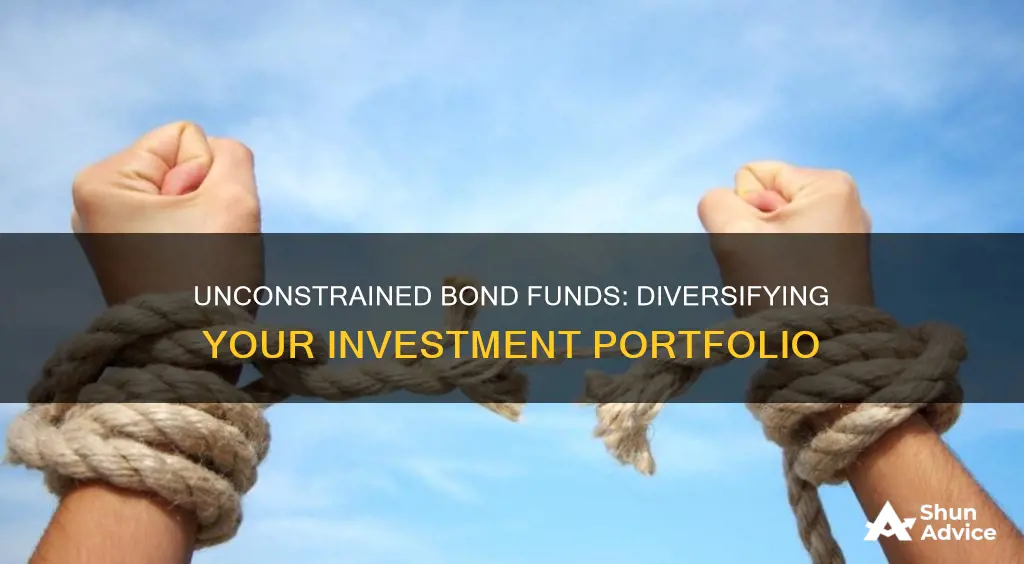
Unconstrained bond funds, also known as [go anywhere funds], are an attractive investment option for those seeking to enhance their bond portfolio's total returns and manage interest rate risk. These funds offer greater flexibility to managers, allowing them to pursue returns across multiple asset classes and sectors without being tied to a specific benchmark. This freedom enables managers to make timely decisions and take advantage of market changes. However, it's important to remember that this increased flexibility also comes with higher investment manager risk, as independent decisions by managers can potentially hurt a portfolio.
Unconstrained bond funds are particularly appealing in a rising interest rate environment as they can limit interest rate risk by maintaining shorter durations than core bond funds. This type of fund has gained popularity, with assets under management in the top 10 nontraditional bond funds increasing significantly in recent years.
While unconstrained bond funds offer benefits, it's crucial to carefully assess the risks associated with them. They may introduce different types of risks, such as market-timing risk, increased volatility, and higher costs. Additionally, the lack of a specific benchmark can make it challenging to evaluate and control risks effectively.
Overall, unconstrained bond funds can be a valuable addition to an investment portfolio, but investors should carefully consider the potential benefits and drawbacks before making any decisions.
| Characteristics | Values |
|---|---|
| Type of Investment | Fixed-income investment strategy |
| Purpose | Enhance a bond portfolio's total returns, manage interest rate risk, diversify a portfolio |
| Investment Style | Unconstrained investing allows managers to pursue returns across many asset classes and sectors |
| Independence from Benchmarks | Unconstrained bond managers are free to invest based on the merits of each individual holding |
| Interest Rate Risk | Ability to choose instruments with relatively short durations to protect the value of a fixed-income portfolio in rising-rate scenarios |
| Total Return | Investing a portion of a fixed-income portfolio in an unconstrained bond strategy can enhance its growth potential |
| Credit Risk | Investors may be exposed to increased credit risk and higher volatility compared to a traditional bond portfolio |
| Currency Volatility | Unconstrained bond strategies may be exposed to currency volatility and political instability |
| Risk Control | Managers use a variety of tools to gauge risk, but most funds use an absolute return "benchmark" |
| Fund Marketing | Fund marketers pitch the idea of returns commensurate with intermediate-term bond funds, without interest-rate sensitivity and without losses |
| Fund Fees | Non-traditional bond funds nearly always come with higher fees |
What You'll Learn

Unconstrained bond funds are not tied to a single fixed income sector
Unconstrained bond funds, also known as "go anywhere" funds, are not tied to any single fixed-income sector. This means that fund managers have the flexibility to invest across a wide range of sectors and asset classes without being restricted to a specific benchmark. This approach allows managers to pursue their investment objectives and target specific returns, such as total return or high yields.
The independence from benchmarks is a key advantage of unconstrained bond funds. Conventional bond indices are weighted by issuance, giving the largest positions to the most indebted institutions. In contrast, unconstrained bond managers can make investment decisions based on the merits of individual holdings, potentially leading to greater risk-adjusted returns. They have the freedom to invest in any type of fixed-income security, anywhere in the world, regardless of credit quality and duration.
The broad mandate of unconstrained bond funds allows managers to assess market conditions and invest in opportunities that may arise across different sectors and geographies. This flexibility is particularly valuable in a dynamic market environment, enabling managers to take advantage of market changes in a timely manner. However, it also increases investment manager risk, as managers operating with more independence may make poor decisions that negatively impact the portfolio's performance.
Unconstrained bond funds typically have broad freedom to manage interest-rate sensitivity. They can choose instruments with relatively short durations to protect the value of the portfolio in rising-rate scenarios. This feature is especially attractive in a low-interest-rate environment, where investors are concerned about the duration risk of traditional bond funds.
While unconstrained bond funds offer the potential for higher total returns and enhanced portfolio growth, it is important to carefully review the specific strategy and risk profile of each fund. The experience and skill of the management team are crucial factors in the success of unconstrained bond strategies, as they must navigate complex global and sector trends to find the best investment opportunities.
Vanguard Funds: Best Investment Options for Your Portfolio
You may want to see also

They can limit interest rate risk
Unconstrained bond funds are a type of fixed-income investment strategy that can be used to manage interest rate risk. They are called "go anywhere" funds because they are not tied to any single fixed-income sector. This means that they can invest in a broad range of fixed-income securities worldwide, with any credit quality and duration.
The ability to invest across a diverse range of assets allows unconstrained funds to limit interest rate risk. When faced with rising interest rates, managers of these funds can choose instruments with relatively short durations to protect the value of the overall fixed-income portfolio. This is in contrast to traditional bond funds, which are dominated by interest rate risk due to their longer durations.
For example, during a period of rising interest rates, an unconstrained fund manager can select instruments with shorter durations, reducing the impact of rising rates on the portfolio's value. This flexibility is particularly advantageous when rates are expected to rise, as unconstrained funds can adapt their investments to mitigate potential losses.
Unconstrained funds also have the advantage of being "benchmark-agnostic". Traditional bond funds often use benchmarks such as the Barclays Aggregate, which focuses on investment-grade securities. In contrast, unconstrained funds are not tied to specific benchmarks, allowing them to pursue returns across multiple asset classes and sectors. This flexibility enables them to limit interest rate risk by diversifying their investments.
However, it is important to note that unconstrained funds are not entirely immune to interest rate risk. They can still be impacted by market changes and are subject to other types of risks, such as credit and geopolitical risks. Additionally, the increased flexibility of unconstrained funds can lead to higher costs and increased investment manager risk, as managers have more independence in their decision-making.
Best Mutual Funds to Invest in India: Top Picks
You may want to see also

They are benchmark-agnostic
Unconstrained bond funds are "benchmark-agnostic", meaning they are not tied to any single fixed-income sector or benchmark. This allows fund managers to pursue returns across multiple asset classes and sectors without being tied to a specific performance benchmark.
This flexibility enables managers to take advantage of market changes in a timely manner and pursue investment themes and ideas without the constraints of benchmark tracking. For example, unconstrained bond fund managers can invest in derivatives to hedge against price and rate ranges and bet against the market through put options.
The independence from benchmarks also means that unconstrained bond managers can make investment decisions based on the merits of each individual holding, potentially leading to greater risk-adjusted returns. They can assess market conditions and invest in any type of fixed-income security, anywhere in the world, with any credit quality and duration.
However, this freedom to invest anywhere in the world can also expose unconstrained bond strategies to currency volatility, political instability, and other risks associated with international holdings. Additionally, it increases investment manager risk, as managers operating more independently may make poor decisions that negatively impact the portfolio.
Therefore, while the benchmark-agnostic nature of unconstrained bond funds provides opportunities for active sector allocation and flexibility in decision-making, it also comes with increased risks that investors should carefully consider.
Golden Butterfly Portfolio: Best Funds for Long-Term Wealth
You may want to see also

They can be used to enhance a bond portfolio's total returns
Unconstrained bond funds can be used to enhance a bond portfolio's total returns. They are a fixed-income investment strategy that can increase the growth potential of a bond portfolio.
Unconstrained bond funds are not limited to the securities in any one benchmark or sector. They are free to pursue whatever objectives they want, such as total return or high yields, and can invest anywhere in the global fixed-income markets. This means they can assess market conditions and invest in any type of fixed-income security, anywhere in the world, with any credit quality and duration.
The strategy typically includes investments in higher-yielding assets, which may expose investors to increased credit risk and higher volatility compared to a traditional bond portfolio. However, that volatility tends to be lower than most equity strategies. Unconstrained bond funds can also provide greater risk-adjusted returns by allowing managers to invest based on the merits of each individual holding, rather than being weighted by issuance like conventional bond indices.
The freedom to invest anywhere in the world can, however, expose unconstrained bond strategies to currency volatility, political instability, and other risks related to international holdings. It is important for investors to carefully review any potential unconstrained bond investment to understand the particular strategy its managers are following, as the experience and skill of the management team are paramount.
Mutual Funds: US Market Investment Options for Indians
You may want to see also

They can be used to diversify a portfolio
Unconstrained bond funds can be used to diversify an investment portfolio. They are a type of fixed-income investment strategy that allows fund managers to pursue returns across multiple asset classes and sectors without being tied to a specific benchmark. This flexibility enables managers to take advantage of market changes and allocate investments across the global fixed-income spectrum.
Unconstrained bond funds are often referred to as "go anywhere" funds because they are not restricted to any single fixed-income sector. They can invest in a diverse range of fixed-income securities worldwide, with varying credit qualities and durations. This diversification helps to spread risk and potentially enhance portfolio returns.
By investing in unconstrained bond funds, investors can access a broader set of opportunities and reduce their exposure to interest rate risk. Unconstrained funds can maintain shorter durations than core bond funds, which is advantageous when interest rates rise. This feature is particularly attractive in a rising interest rate environment, as it helps protect the value of the overall fixed-income portfolio.
Additionally, unconstrained bond funds can provide higher total returns compared to traditional bond portfolios. They typically include investments in higher-yielding assets, which may expose investors to increased credit risk and higher volatility. However, the volatility tends to be lower than most equity strategies, making it a more attractive option for risk-averse investors.
It is important to note that while unconstrained bond funds offer diversification benefits, they also come with their own set of risks. The independence from benchmarks and the ability to invest globally can expose these funds to currency volatility, political instability, and other international risks. Therefore, investors should carefully assess the experience and skill of the fund managers before investing.
Investing in Commodities: A Smart Fund Move?
You may want to see also







